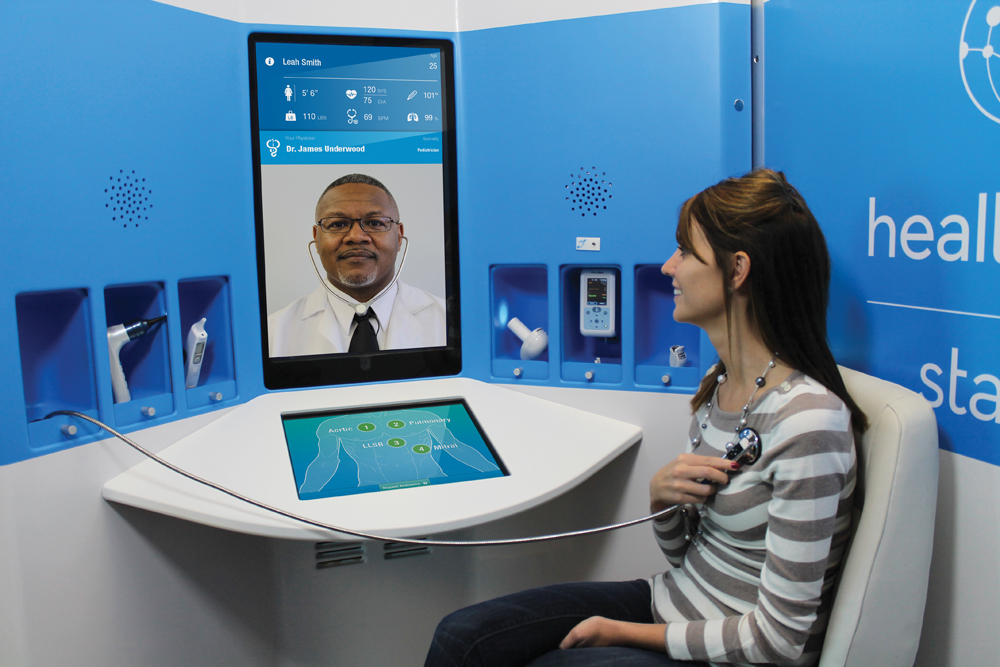The HealthSpot station is an 8x5-foot, ADA-compliant mobile kiosk that lets patients access a network of board-certified physicians through interactive videoconferencing and medical devices, such as stethoscopes, scanners, and thermometers. From that information, the remote doctors can make diagnoses and prescribe advice and medicine.
“We’re bringing the doctor to the patient,” says Steve Cashman, CEO and Founder of Dublin, Ohio-based HealthSpot, which launched its first station at the Consumer Electronics Show last December.
As of mid-October, about a dozen HealthSpots were in use. Eight healthcare systems in Minnesota, Miami, San Diego, and Ohio—including the prestigious Cleveland Clinic—were making caregivers available. Customers can be treated for common health conditions—colds and flu, rashes and skin conditions, eye conditions, earaches, and seasonal allergies.
On November 10, pharmacy chain Rite Aid announced that it had entered into an agreement with HealthSpot to install stations at select Rite Aid locations in the Akron/Canton, Cleveland, and Dayton/Springfield markets in Ohio.
The HealthSpot station was designed by Cleveland-based architectural firm Nottingham Spirk. Bill Nottingham, a Principal, says the station had to be portable, but not so small as to feel claustrophobic. An arched ceiling gives the pod some breathing room
Ohio-based Commercial Vehicle Group, a manufacturer of truck cabs, makes the stations. The units are shipped in pieces and reassembled on site. HealthSpot is providing the units to client locations for a one-time implementation fee to cover the installation, plus a monthly maintenance and licensing fee. Cashman estimates the stations are profitable when they handle at least six patients a day.
Cashman says he plans to place another 100 HealthSpots into the market in early 2015. He says he envisions them being installed on college campuses, in retail malls, and in assisted living facilities.
Read about more innovations from BD+C's 2014 Great Solutions Report
Related Stories
| Jan 9, 2015
Nonresidential construction hiring surges in December 2014
The U.S. construction industry added 48,000 jobs in December, including 22,800 jobs in nonresidential construction, according to the Bureau of Labor Statistics preliminary estimate released Jan. 9.
| Jan 9, 2015
10 surprising lessons Perkins+Will has learned about workplace projects
P+W's Janice Barnes shares some of most unexpected lessons from her firm's work on office design projects, including the importance of post-occupancy evaluations and having a cohesive transition strategy for workers.
| Jan 9, 2015
Technology and media tenants, not financial companies, fill up One World Trade Center
The financial sector has almost no presence in the new tower, with creative and media companies, such as magazine publisher Conde Nast, dominating the vast majority of leased space.
| Jan 8, 2015
Microsoft shutters classic clipart gallery: Reaction from a graphic designer
Microsoft shut down its tried-and-true clipart gallery, ridding the world not only of a trope of graphic design, but a nostalgic piece of digital design history, writes HDR's Dylan Coonrad.
| Jan 8, 2015
The future of alternative work spaces: open-access markets, co-working, and in-between spaces
During the past five years, people have begun to actively seek out third places not just to get a day’s work done, but to develop businesses of a new kind and establish themselves as part of a real-time conversation of diverse entrepreneurs, writes Gensler's Shawn Gehle.
Smart Buildings | Jan 7, 2015
NIBS report: Small commercial buildings offer huge energy efficiency retrofit opportunities
The report identifies several barriers to investment in such retrofits, such as the costs and complexity associated with relatively small loan sizes, and issues many small-building owners have in understanding and trusting predicted retrofit outcomes.
| Jan 7, 2015
University of Chicago releases proposed sites for Obama library bid
There are two proposed sites for the plan, both owned by the Chicago Park District in Chicago’s South Side, near the university’s campus in Hyde Park, according to the Chicago Sun-Times.
| Jan 7, 2015
4 audacious projects that could transform Houston
Converting the Astrodome to an urban farm and public park is one of the proposals on the table in Houston, according to news site Houston CultureMap.
| Jan 7, 2015
How you can help improve the way building information is shared
PDFs are the de facto format for digital construction documentation. Yet, there is no set standard for how to produce PDFs for a project, writes Skanska's Kyle Hughes.
Smart Buildings | Jan 7, 2015
Best practices for urban infill development: Embrace the region's character, master the pedestrian experience
If an urban building isn’t grounded in the local region’s character, it will end up feeling generic and out-of-place. To do urban infill the right way, it’s essential to slow down and pay proper attention to the context of an urban environment, writes GS&P's Joe Bucher.
















